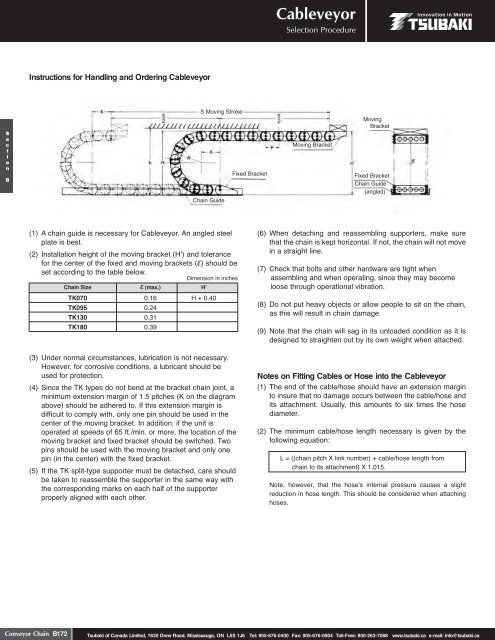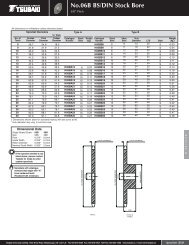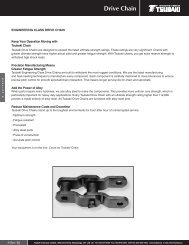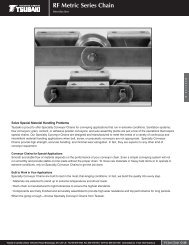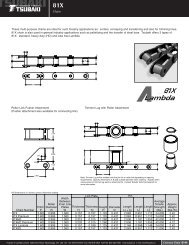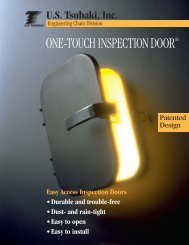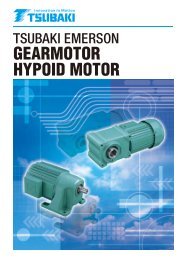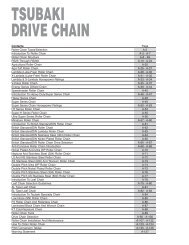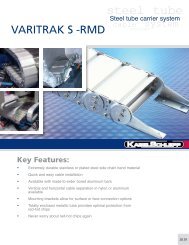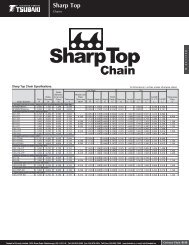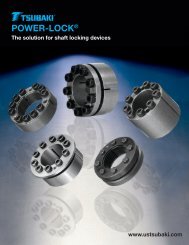Conveyor Chain - Tsubaki
Conveyor Chain - Tsubaki
Conveyor Chain - Tsubaki
- No tags were found...
You also want an ePaper? Increase the reach of your titles
YUMPU automatically turns print PDFs into web optimized ePapers that Google loves.
CableveyorSelection ProcedureInstructions for Handling and Ordering CableveyorSectionBS Moving StrokeFixed BracketMoving BracketMovingBracketFixed Bracket<strong>Chain</strong> Guide(angled)<strong>Chain</strong> Guide(1) A chain guide is necessary for Cableveyor. An angled steelplate is best.(2) Installation height of the moving bracket (Hʼ) and tolerancefor the center of the fixed and moving brackets (E) should beset according to the table below.Dimension in inches<strong>Chain</strong> Size E (max.) HʼTK070 0.16 H + 0.40TK095 0.24TK130 0.31TK180 0.39(3) Under normal circumstances, lubrication is not necessary.However, for corrosive conditions, a lubricant should beused for protection.(4) Since the TK types do not bend at the bracket chain joint, aminimum extension margin of 1.5 pitches (K on the diagramabove) should be adhered to. If this extension margin isdifficult to comply with, only one pin should be used in thecenter of the moving bracket. In addition, if the unit isoperated at speeds of 65 ft./min. or more, the location of themoving bracket and fixed bracket should be switched. Twopins should be used with the moving bracket and only onepin (in the center) with the fixed bracket.(5) If the TK split-type supporter must be detached, care shouldbe taken to reassemble the supporter in the same way withthe corresponding marks on each half of the supporterproperly aligned with each other.(6) When detaching and reassembling supporters, make surethat the chain is kept horizontal. If not, the chain will not movein a straight line.(7) Check that bolts and other hardware are tight whenassembling and when operating, since they may becomeloose through operational vibration.(8) Do not put heavy objects or allow people to sit on the chain,as this will result in chain damage.(9) Note that the chain will sag in its unloaded condition as it isdesigned to straighten out by its own weight when attached.Notes on Fitting Cables or Hose into the Cableveyor(1) The end of the cable/hose should have an extension marginto insure that no damage occurs between the cable/hose andits attachment. Usually, this amounts to six times the hosediameter.(2) The minimum cable/hose length necessary is given by thefollowing equation:L = {(chain pitch X link number) + cable/hose length fromchain to its attachment} X 1.015.Note, however, that the hoseʼs internal pressure causes a slightreduction in hose length. This should be considered when attachinghoses.<strong>Conveyor</strong> <strong>Chain</strong> B172<strong>Tsubaki</strong> of Canada Limited, 1630 Drew Road, Mississauga, ON L5S 1J6 Tel: 905-676-0400 Fax: 905-676-0904 Toll-Free: 800-263-7088 www.tsubaki.ca e-mail: info@tsubaki.ca


